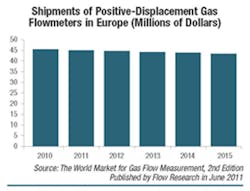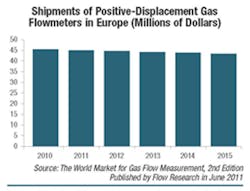PD meters are very effective at making low-cost mechanical measurements for utility purposes. These include residential, commercial and industrial utility applications. In these segments, the main competition for PD meters is from single-jet, multi-jet, compound, and Woltman turbine meters rather than from new-technology meters. The reason is that industry approvals for utility and billing for new-technology meters, such as magnetic and Coriolis, are at least several years away. This market segment is growing.
Technology improvements are also occurring within the PD gas flow market. Rotary PD meters are replacing the older-style diaphragm meters. These newer rotary meters are smaller and lighter than the diaphragm meters. In some cases, when customers take a diaphragm PD meter out of service, they replace it with a rotary PD meter. Rotary meters represent a newer technology, and they allow end-users to upgrade their measurement capability while staying within the class of PD meters.
Overall, there are two main disadvantages to PD flowmeters that have not been overcome by new research and development in this technology. The first is that they have internal moving parts that are subject to wear. And the second is that the basic design of the meter calls for there to be an obstruction in the flowstream, causing a pressure drop.
Beyond these technical considerations, PD meter shipments tend to track population and economic trends rather closely. A prime example of this is their still-popular use in commercial and residential gas metering. As commercial and residential development ebbs and flows with the general economy, PD meters rise and fall in demand because of their place in distribution and retail applications in the downstream end of their market.
PD flowmeters are being displaced by new-technology meters in several areas. A notable instance is industrial gas measurement, where Coriolis meters offer a superior alternative for many end-users. PD meters are also being displaced by Coriolis flowmeters for liquid applications in distribution of petroleum products because of the high-accuracy and long-term reliability of Coriolis meters.



